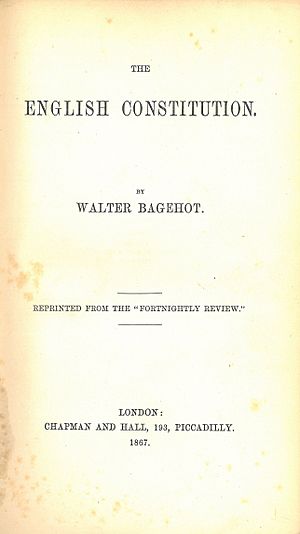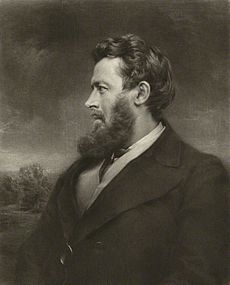The English Constitution facts for kids

Title page of the first edition
|
|
| Author | Walter Bagehot (3 February 1826 – 24 March 1877) |
|---|---|
| Country | United Kingdom |
| Language | English |
| Publisher | Chapman & Hall |
|
Publication date
|
1867 |
| Pages | 348 |
| OCLC | 60724184 |
The English Constitution is an important book by Walter Bagehot. It was first published in parts between 1865 and 1867. The book then came out as a full book in 1867. It looks closely at how the constitution of the United Kingdom works. This includes how the Parliament and the British monarchy operate. Bagehot also compares the British system with the American government. This book became a very well-known work. It was translated into many different languages.
Even though some of Walter Bagehot's ideas about Parliament are now outdated, his thoughts on the monarchy are still very important. They help us understand the main ideas of a constitutional monarchy.
Contents
What is The English Constitution About?
Bagehot started his book by saying we should not just look at how a government is supposed to work on paper. Instead, we should focus on how it really works in practice. He believed it was important to see where the true power lies. He said that old ideas about dividing power were wrong. These ideas suggested power was split between law-making, carrying out laws, and judging.
Dignified and Efficient Parts of Government
Bagehot said that the British system has two main parts. He called these the 'dignified parts' and the 'efficient parts'. The dignified parts are those that people respect and admire. They help people feel loyal to the country. The efficient parts are the ones that actually run the country. They make the decisions and do the work.
He explained that the dignified parts impress many people. They make the government seem strong and important. This helps the government gain trust and power. The efficient parts then use this trust to rule. Bagehot thought that the dignified parts were old and grand. But the efficient parts were simple and modern.
The Monarchy's Role
The 'efficient secret' of the system was the close link between the government and the law-making body. This link is found in the Cabinet. The Cabinet is like a main group that rules the nation. Bagehot said the Queen's role, as a dignified part, was very valuable. It helped to make the government stronger. He famously said the monarch has three rights:
- The right to be consulted (asked for advice).
- The right to encourage (give support).
- The right to warn (give cautions).
The House of Lords and Commons
The House of Lords also had a dignified role. It was a place that could delay laws or suggest changes. But it had to agree with the House of Commons in the end. Bagehot joked that to stop admiring the House of Lords, you just needed to go and see it. He thought it should be reformed. He supported creating life peers to help it.
The House of Commons was one of the efficient parts. It was the main place where English politics happened. The Commons was the 'ruling and choosing House'. Its main job was to choose the country's leaders. It also had other jobs:
- To show what the people thought.
- To teach the nation.
- To share complaints.
- To make laws.
Bagehot knew that political parties were a natural part of the Commons. But he saw party politics as being flexible and focused on Parliament.
Changes to Voting Rights
Bagehot was worried about too much democracy. He did not like the idea of 'one person, one vote'. He thought that if too many people who were not educated started to rule, it would cause problems. He believed that the middle classes were the most powerful group in England. He expected them to choose good lawmakers. These lawmakers would then pick a good government.
Bagehot was okay with some small changes to Parliament. He thought it was fine to give more power to industrial areas. He even allowed for some working-class people to be representatives. But he was very shocked by the Second Reform Act of 1867. This law greatly increased the number of people who could vote. It almost doubled the size of the voters.
In 1872, Bagehot wrote a new introduction to his book. He was worried about the future. He thought that both political parties would try to get the support of working people. He feared they would promise to do whatever the working people wanted. He admitted he was "exceedingly afraid" of the many new voters.
Who Did Bagehot Influence?
A section in The Economist magazine, which talks about British issues, is named after Bagehot. Bagehot also had an impact on Woodrow Wilson. Wilson wrote a book called Congressional Government: A Study in American Politics in 1885. He was inspired by The English Constitution. Joaquim Nabuco was also influenced by Bagehot's book. He wrote a whole chapter about it in his own memories.
Many British monarchs and their future kings or queens have studied Bagehot's ideas. In the first season of the TV show The Crown, young Princess Elizabeth's teacher quotes Bagehot to her. She later remembers this when she becomes Queen Elizabeth II.
Sources
- McMaster University version.
- Project Gutenberg version (EBook #4351, posted on 11 August 2009).
- Briggs, Asa, “Trollope, Bagehot, and the English Constitution,” in Briggs, Victorian People (1955) pp. 87–115. online


